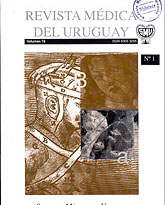Vigilance of antibiotic use in a pediatric hospital (Hospital Pediátrico del Centro Hospitalario Pereira Rossell)
Antimicrobial susceptibility; cost and consumption antibiotics
Abstract
Background. Guidelines for empirical antibiotic treatment are a primary strategy to prevent the sustainable increased in bacterial resistance and costs. Since 1998, when a guideline for empirical antibiotic treatment for the most frequent infections in general ward and emergency units was adapted in the Hospital Pediátrico del Centro Hospitalario Pereira Rossell- HP-CHPR), this study began.
Objective. To analyze antibiotic overuse and costs, and antimicrobial susceptibility.
Method. Recommended antibiotics (by Hospital Guidelines: penicillin, aminopenicillin, cefalosporine, macrolides) costs were calculated for both general wards and emergency units. Consumption per in-hospital-patient was calculated on basis of defined daily dose (DDD)/100 day-beds for each antibiotic. Cost/consumption antibiotic for the period 2001-2002 were compared, antimicrobial susceptibility of the most frequent germens during 2001-2002 was compared to adapted therapeutic guidelines.
Results. Recommended antibiotic cost was in 2001 57% of antibiotic cost (2.206.652.57 pesos), in 2002 54% (1.441.280 pesos). Aminopenicillin was the antibiotic most frequently used. Intravenous cefuroxime consumption decreased 60% (from 13.1 to 5.36 DDD/100 day-beds). Intravenous ceftriaxone and oral amoxicillin increased 38% and 16% respectively. Consumption of other antibiotics remained constant. Antimicrobial susceptibility rates of most frequent germens (S. pseumoniae, S. aureus, E. coli, Shigella spp) to recommended antibiotics remained over 80%.
Conclusions. These are the first results of vigilance antibiotic use in HP-CHPR; they show the actuality and acceptance of the empirical antibiotic therapy guidelines proposed. Decrease in antibiotic cost is complex since cost variance during the same period.
References
2) Schwartz B, Mainons A, Marcy S. With do physicians prescribe antibiotics for children with upper respiratory tract infections? JAMA 1998; 279 (11): 881-2.
3) Wang EE, Einarson TR, Kellner JD, Conly JM. Antibiotic prescribing for Canadian preschool children: evidence of overprescribing for viral respiratory infections. Clin Infect Dis 1999; 29(1): 155-60.
4) Mölstad S, Cars O. Major change in the use of antibiotics following a national programme: Swedish Strategic Programme for the Rational Use of Antimicrobial Agents and Surveillance of Resistance (STRAMA). Scand J Infect Dis 1999; 31(2): 191-5.
5) Giachetto G, Álvarez C, Arnaud H, Bruno P, Da Silva E, De Salterain H, et al. Uso de antibióticos en servicios de internación pediátrica. Rev Med Uruguay 2001; 17(1): 55-61.
6) Bamberger DM, Dahl SL. Impact of voluntary vs. enforced compliance of third-generation cephalosporin use in teaching hospital. Arch Intern Med 1992; 152(3): 554-7.
7) White AC, Atmar RL, Wilson J, Cate TR, Stager CE, Greenberg SB. Effects of requiring prior authorization for selected antimicrobials: expenditures, susceptibilities, and clinical outcomes. Clin Infect Dis 1997; 25(2): 230-9.
8) Sáez-Llorens X, Castrejón de Wong MM, Castaño E, De Suman O, De Morös D, De Atencio I. Impact of an antibiotic restriction policy on hospital expenditures and bacterial susceptibilities: a lesson from a pediatric institution in a developing country. Pediatr Infect Dis J 2000; 19(3): 200-6.
9) Universidad de la República. Facultad de Medicina. Departamento de Emergencia Pediátrica. Clínicas Pediátricas A, B, C. Pautas de diagnóstico, tratamiento y prevención. In: Atención Pediátrica. 5 ed. Montevideo: Oficina del Libro AEM, 2000: 99-101; 109-115; 131-138; 157-162; 201-205; 231-240.
10) Capella D, Laporte JR. Métodos aplicados en estudios descriptivos de utilización de medicamentos. In: Laporte JR, Tognoni G. Principios de epidemiología del medicamento. 2 ed. Barcelona: Masson-Salvat, 1993: 67-93.
11) National Committee for Clinical Laboratory Standards. Performance Standards for Antimicrobial Disk Susceptibility Tests. Approved Standard M2A7. Wayne, PA: NCCLS; 2000.
12) National Committee for Clinical Laboratory Standars. Performance Standards for Antimicrobial Susceptibility Tests (M 100-S8). Villanova, Pa: NCCLS, 1998. vol. 18.
13) World Health Organization. Containing Antimicrobial resistance: review of the Literature and Report of a WHO Workshop on the Development of a Global Strategy for the Containment of Antimicrobial Resistance. Geneva: WHO, 1999: 1-54.
14) Laing RO, Hogerzeil HV, Ross-Degnan D. Ten recommendations to improve use of medicines in developing countries. Health Policy Plan 2001; 16(1):13-20.

This work is licensed under a Creative Commons Attribution-NonCommercial 4.0 International License.













